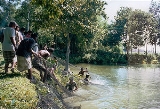
Fishing in Bangladesh
Encyclopedia

Indian Ocean
The Indian Ocean is the third largest of the world's oceanic divisions, covering approximately 20% of the water on the Earth's surface. It is bounded on the north by the Indian Subcontinent and Arabian Peninsula ; on the west by eastern Africa; on the east by Indochina, the Sunda Islands, and...
has a very good source of marine resources in the Bay of Bengal
Bay of Bengal
The Bay of Bengal , the largest bay in the world, forms the northeastern part of the Indian Ocean. It resembles a triangle in shape, and is bordered mostly by the Eastern Coast of India, southern coast of Bangladesh and Sri Lanka to the west and Burma and the Andaman and Nicobar Islands to the...
. The country has an exclusive economic zone of 41000 square miles (106,189.5 km²), which is 73% of the country’s land area. On the other hand, Bangladesh is a small and developing country overloaded with almost unbearable pressure of human population. In the past, people of Bangladesh were mostly dependent upon land-based proteins. But, the continuous process of industrialization and urbanization consumes the limited land area. Now there is no other way than to harvest the vast under water protein
Protein
Proteins are biochemical compounds consisting of one or more polypeptides typically folded into a globular or fibrous form, facilitating a biological function. A polypeptide is a single linear polymer chain of amino acids bonded together by peptide bonds between the carboxyl and amino groups of...
from the Bay of Bengal, which can meet the country's demand.
More than 80 percent of the animal protein in the Bangladeshi diet comes from fish
Fish
Fish are a paraphyletic group of organisms that consist of all gill-bearing aquatic vertebrate animals that lack limbs with digits. Included in this definition are the living hagfish, lampreys, and cartilaginous and bony fish, as well as various extinct related groups...
. Fish accounted for 6 percent of GDP in the fiscal year of 1970, nearly 50 percent more than modern industrial manufacturing at that time. Most commercial fishermen are low-caste
Caste
Caste is an elaborate and complex social system that combines elements of endogamy, occupation, culture, social class, tribal affiliation and political power. It should not be confused with race or social class, e.g. members of different castes in one society may belong to the same race, as in India...
Hindus who eke out the barest subsistence working under primitive and dangerous conditions. They bring a high degree of skill and ingenuity to their occupation; a few of the most enterprising ones are aided by domesticated otters, which behave like shepherds, swimming underwater, driving fish toward the fisherman's net (and being rewarded themselves with a share of the catch). Fish for local consumption are generally of freshwater varieties.
As of the end of 1987, prevailing methods for culturing shrimp
Shrimp
Shrimp are swimming, decapod crustaceans classified in the infraorder Caridea, found widely around the world in both fresh and salt water. Adult shrimp are filter feeding benthic animals living close to the bottom. They can live in schools and can swim rapidly backwards. Shrimp are an important...
in Bangladesh were still relatively unsophisticated, and average yields per hectare were low. In the late 1980s, almost all inland shrimping was done by capture rather than by intensive aquaculture. Farmers relied primarily on wild postlarval and juvenile shrimp as their sources of stock, acquired either by trapping in ponds during tidal water
Tide
Tides are the rise and fall of sea levels caused by the combined effects of the gravitational forces exerted by the moon and the sun and the rotation of the Earth....
exchange or by gathering from local estuaries and stocking directly in the ponds. Despite the seemingly low level of technology applied to shrimp aquaculture, it became an increasingly important part of the frozen seafood industry in the mid-1980s.
The World Bank
World Bank
The World Bank is an international financial institution that provides loans to developing countries for capital programmes.The World Bank's official goal is the reduction of poverty...
and the Asian Development Bank
Asian Development Bank
The Asian Development Bank is a regional development bank established on 22 August 1966 to facilitate economic development of countries in Asia...
financed projects to develop shrimp aquaculture in the 1980s. Much of the emphasis was on construction of modern hatcheries. Private investors were also initiating similar projects to increase capacity and to introduce modern technology that would increase average yields.
Training for the fishing industry
Fishing industry
The fishing industry includes any industry or activity concerned with taking, culturing, processing, preserving, storing, transporting, marketing or selling fish or fish products....
of Bangladesh, as well as for merchant shipping and related maritime industries is provided by the Bangladesh Marine Fisheries Academy
Bangladesh Marine Fisheries Academy
Bangladesh Marine Fisheries Academy is a government-run training institution in Bangladesh for cadets wishing to enter the fishing industry, merchant shipping and other related maritime industries...
.

